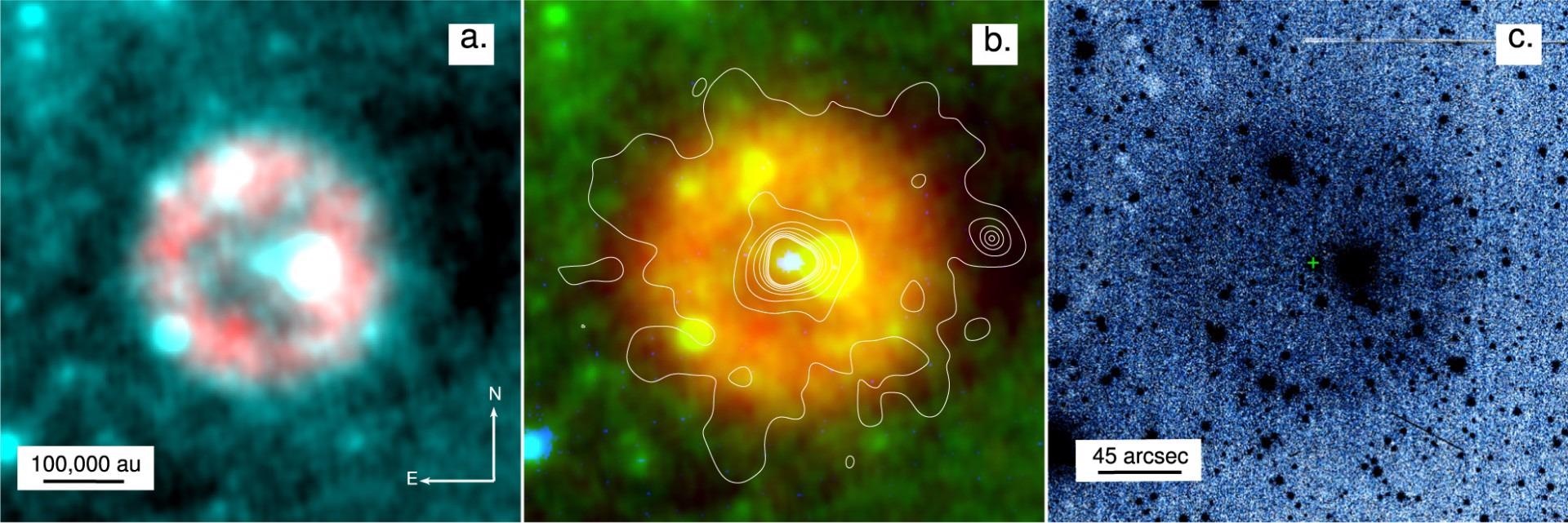An international team of astronomers has solved a 900-year-old question regarding the origin of a famous supernova first spotted in China around 1181AD.
 (a) WISE false color image of Pa 30 where blue and green stand for 11 μm emission, and red for 22 μm. Here, the levels of the 22 μm component have been adjusted to enhance the ring-like feature. (b) In this false color image, where green stands for WISE 11 μm (as in the left panel) and red for WISE 22 μm (adjusted to show extended emission), the emission from the central star is highlighted in blue from the GALEX near-UV data, while the XMM-Newton contours (10 levels, linear scale) show that the majority of the X-ray emission originates from the core of the nebula. A background point source is seen westward of the CS in the XMM-Newton contour map. (c) The 2.1 m KPNO [O iii] image, which we have stacked and rebinned from individual frames to enhance the low surface brightness, diffuse shell. The green cross in the center of the image marks the location of the CS. Panels (a)–(c) are reproduced at the same angular scale and orientation. At the Gaia distance of Pa 30 of 2.30 ± 0.14 kpc, an angular scale of 45″ translates to about 100,000 au. Image Credit: University of Manchester.
(a) WISE false color image of Pa 30 where blue and green stand for 11 μm emission, and red for 22 μm. Here, the levels of the 22 μm component have been adjusted to enhance the ring-like feature. (b) In this false color image, where green stands for WISE 11 μm (as in the left panel) and red for WISE 22 μm (adjusted to show extended emission), the emission from the central star is highlighted in blue from the GALEX near-UV data, while the XMM-Newton contours (10 levels, linear scale) show that the majority of the X-ray emission originates from the core of the nebula. A background point source is seen westward of the CS in the XMM-Newton contour map. (c) The 2.1 m KPNO [O iii] image, which we have stacked and rebinned from individual frames to enhance the low surface brightness, diffuse shell. The green cross in the center of the image marks the location of the CS. Panels (a)–(c) are reproduced at the same angular scale and orientation. At the Gaia distance of Pa 30 of 2.30 ± 0.14 kpc, an angular scale of 45″ translates to about 100,000 au. Image Credit: University of Manchester.
According to the research, a faint and fast-expanding cloud (or nebula) known as Pa30 enveloping one of the hottest stars in the Milky Way galaxy, called Parker’s Star, suits the profile, age and location of the historic supernova.
The study was recently published in The Astrophysical Journal Letters.
Only five bright supernovae have been observed in the Milky Way in the last millennium starting in 1006. Among all these, the one observed in China known as the “Chinese Guest Star” of 1181 AD was not deeply studied. The supernova was first sighted by Chinese and Japanese astronomers in the 12th century. They noted that it was as bright as the planet Saturn and was seen for six months.
A rough location was also marked in the sky of the sighting. However, a confirmed remnant of the explosion was not identified by modern astronomers. The other four supernovae are familiar to modern-day science. The Crab nebula is one among those.
The puzzle around this 12th-century explosion was solved by a team of international astronomers from Hong Kong, the United Kingdom, Spain, Hungary and France, including Professor Albert Zijlstra from The University of Manchester.
The astronomers observed that the Pa30 nebula is expanding at a high velocity of over 1100 km per second. Traveling at this speed, it would just take 5 minutes to reach the Moon from the Earth. The astronomers use this velocity to derive an age at about 1000 years, which would coincide with the events of 1181 AD.
The historical reports place the guest star between two Chinese constellations, Chuanshe and Huagai. Parker’s Star fits the position well. That means both the age and location fit with the events of 1181.
Albert Zijlstra, Professor in Astrophysics, University of Manchester
Earlier, Pa30 and Parker’s Star were proposed as the result of a merger of two White Dwarfs. These types of events were regarded to result in a rare and relatively faint type of supernova, called “Type Iax supernova.”
Only around 10% of supernovae are of this type and they are not well understood. The fact that SN1181 was faint but faded very slowly fits this type. It is the only such event where we can study both the remnant nebula and the merged star, and also have a description of the explosion itself.
Albert Zijlstra, Professor in Astrophysics, University of Manchester
The results of the merger of remnant stars, white dwarfs and neutron stars are extreme nuclear reactions and the formation of heavy, highly neutron-rich elements like platinum and gold.
Combining all this information such as the age, location, event brightness and historically recorded 185-day duration, indicates that Parker’s star and Pa30 are the counterparts of SN 1181. This is the only Type Iax supernova where detailed studies of the remnant star and nebula are possible. It is nice to be able to solve both a historical and an astronomical mystery.
Albert Zijlstra, Professor in Astrophysics, University of Manchester
Journal Reference:
Ritter, A., et al. (2021) The Remnant and Origin of the Historical Supernova 1181 AD. The Astrophysical Journal Letters. doi.org/10.3847/2041-8213/ac2253.